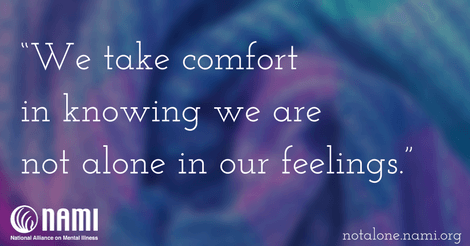May 16, 2017
By Jean Mellano
If you or someone you know is experiencing a mental health, suicide or substance use crisis or emotional distress, reach out 24/7 to the 988 Suicide and Crisis Lifeline (formerly known as the National Suicide Prevention Lifeline) by dialing or texting 988 or using chat services at 988lifeline.org to connect to a trained crisis counselor. You can also get crisis text support via the Crisis Text Line by texting NAMI to 741741.

Suicide survivors belong to an exclusive club with a costly membership fee. As the lyrics from the Eagles song Hotel California say; “you can check out any time you like, but you can never leave.” The same can be said about the house of grief where suicide survivors live.
Since my soulmate of 33 years, Steve, took his own life in March, 2015, I have observed that there are some common ties that bind suicide survivors. Yes, some of these ties are shared by anyone who grieves the loss of a loved one and I am by no means trivializing their pain. We all grieve differently and in different ways for different relationships. However, in the case of suicide survivors, I believe our grief is intensified due to the stigmas associated with suicide and society’s inability to comprehend how someone can take their own life.
In connecting with other suicide survivors, these are the common themes I have seen that many of us share:
Why did he (she) give up hope? What could I have done differently to prevent this tragedy? Why didn’t I see the signs? How could he (she) do this if he (she) loved me? These questions will never have answers and they will always haunt us.
In the case of suicide, more often than not, the loved one’s cause of death is how they are remembered. In the case of death by other circumstances, people are likely to be remembered for their accomplishments and/or who they were as a person.
Yes, we knew something was not right, but we never in a million years would have thought our loved one would die by their own hand.
When there is disagreement within the family as to whether or not to be public with the cause of death, the family can be torn apart. This is so sad since we need each other now more than ever to join hands and console each other on our journey of grief. When fellow suicide survivors turn against us, it further adds to everyone’s pain. This is so ironic because we all loved the one lost to suicide just as they loved all of us.
It is human nature, when trying to make sense of a tragedy, to place blame on someone or something. More often than not, it is unfairly placed on someone who was closest to the lost loved one. As people take “sides” family and friends are torn apart, further compounding the grief and pitting suicide survivor against suicide survivor.
This is mainly self-imposed, however, many longtime friends and acquaintances seem to avoid us. No one knows what to say. We are so weary of heartless comments like: “suicide is a permanent solution to a temporary problem.” We are so worn out by grief, we are too weary and drained to educate, especially since most people are not open to being educated about suicide and are steadfast in their opinions.
This is so sad as it is the farthest thing from the truth. He (she) had no idea how those left behind would suffer after they were gone.
Whether it is ten weeks, ten months or ten years since our loved one’s suicide, the passage of time does not lessen the pain we feel. The waves of grief will still come, sometimes like ripples on the ocean or they could be like crushing tsunamis. I believe time will only lessen the frequency and duration of these waves, not reduce the depth of the pain.
Our tears of sadness sometimes turn to tears of rage because our loved one “gave up” and chose suicide, leaving us to pick up the shattered pieces of their lives. Yet, upon further reflection, we know in our hearts they were suffering intense mental anguish. Then, our tears of anger transform back into tears of sadness.
This, in my mind, stands out as the most prevalent feeling shared by others like myself. We are already grieving a tragic loss and compounding that grief are some or all of the other experiences I have notated above.
I am thankful for all the suicide survivors who have reached out to me and made me feel that I am not alone. They have all inspired me to continue writing about suicide awareness and the collateral damage that results from it.
We’re always accepting submissions to the NAMI Blog! We feature the latest research, stories of recovery, ways to end stigma and strategies for living well with mental illness. Most importantly: We feature your voices.
LEARN MORENAMI HelpLine is available M-F, 10 a.m. – 10 p.m. ET. Call 800-950-6264,
text “NAMI” to 62640, or chat online. In a crisis, call or text 988 (24/7).